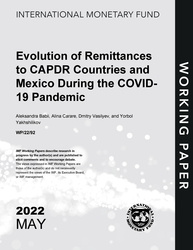
Evolution of Remittances to CAPDR Countries and Mexico During the COVID-19 Pandemic
Evolution of Remittances to CAPDR Countries and Mexico During the COVID-19 Pandemic
READ MORE...
Volume/Issue:
Volume 2022
Issue 092
Publication date: May 2022
ISBN: 9798400210150
$20.00
Add to Cart by clicking price of the language and format you'd like to purchase
Available Languages and Formats
| English |
Prices in red indicate formats that are not yet available but are forthcoming.
Topics covered in this book
This title contains information about the following subjects.
Click on a subject if you would like to see other titles with the same subjects.
Exports and Imports , Labor , Economics- Macroeconomics , Economics / General , Emigration and Immigration , COVID-19 pandemic , migrant remittances , international migration , remittances dynamics , B , panel Vector Autoregression Model , remittances growth , evolution of remittance , remittances to CAPDR country , Remittances , Real wages , COVID-19 , Migration , Unemployment , Central America
Also of interest
Summary
Traditional models relying on standard variables like the U.S. Hispanic unemployment rate fared well in explaining remittances to CAPDR and Mexico during the pre-pandemic period. However, they fail to predict the sustained growth in remittances since June 2020, including the significant increase in the average amount remitted. Using data from over 300 remittances corridors (from 23 U.S. states to 14 Salvadoran departments), we find that this increase is primarily explained by the dynamics of U.S. states real wages, as well as more temporary factors like U.S. unemployment relief (including the extraordinary pandemic support), U.S. states mobility, and COVID-19 infections at home. The paper also analyses what role the change in the modes of transmission of remittances, additional U.S. fiscal stimulus and U.S. labor market developments, especially in the sectors were CAPDR and Mexican migrants preponderantly work, play in explaining aggregate remittances growth.
Copyright © 2010 - 2025
Powered by:
AIDC



